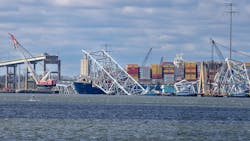NTSB Releases Report on Cause of Key Bridge Collapse
Investigators with the National Transportation Safety Board (NTSB) have released an initial report of some of the causes of Baltimore’s Francis Scott Key Bridge collapse, including a loose cable that could have caused electrical issues on the Dali cargo ship.
When disconnected, the problematic cable triggered an electrical blackout on the ship similar to what happened as it approached the bridge on March 26, according to the new documents by the NTSB.
The documents don’t include any analysis or conclusions, which will be released later in the board’s final report.
The Dali was leaving Baltimore bound for Sri Lanka when its steering failed because of the power loss. It crashed into one of the bridge’s supporting columns, destroying the 1.6-mile span and killing six members of a roadwork crew.
Safety investigators released a preliminary report earlier this year that documented a series of power issues on the ship before and after its departure from Baltimore. But the new records offer more details about how its electrical system may have failed in the critical moments leading up to the collapse.
The Dali first experienced a power outage when it was still docked in Baltimore. That was after a crew member mistakenly closed an exhaust damper while conducting maintenance, causing one of the ship’s diesel engines to stall, according to the earlier report.
Crew members then made changes to the ship’s electrical configuration, switching from one transformer and breaker system to a second that was active upon its departure. That second transformer and breaker system is where investigators found the loose cable, according to investigative reports.
Engineers from Hyundai, the manufacturer of the ship’s electrical system, said the loose cable could create an open circuit and cause a breaker to open. The engineers disconnected the cable as part of a simulation, which resulted in a blackout on the ship.
The new documents also included various certificates issued after inspections of the Dali pertaining to its general condition and compliance with maritime safety regulations.
Investigations are still ongoing according to the NTSB, with the agency’s final report on the causes of the crash to come.
Source: MSN.com, ABCNews.com
